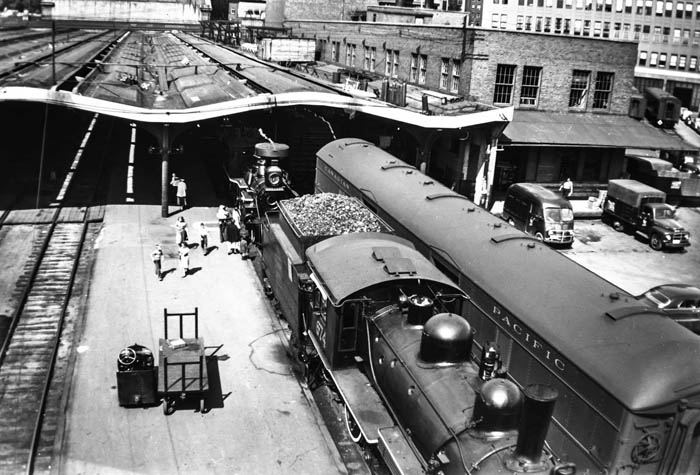
 The locomotive in the foreground is CN 2-6-0 Mogul No. 674. Coupled behind it is almost certainly CN 4-4-0 No. 40 and just visible under the trainshed roof is what appears to be the headlight of 0-6-0T No, 247. Old Cabbage Stacker Pulls Museum Train to City for Week's Showing, Published 23 August 1954 "All aboard for yesterday" somebody might well have cried as a train right out of the 19th century rolled into the Union Station this morning. It was the Canadian National Railway's Museum Train,and at the throttle for a dry run was Mayor Charlotte Whitton. The whole train looks as if it were strictly from Walt Disney - in technicolor. A Citizen reporter had a private trip. He rode the plush from the depot to the Deep Cut, on to Ottawa East, out to Hurdman, then back to the station again. Rail Fan's Dream This is the kind of train that makes a rail fan's mouth water. Here are engines you never believed you would see in this world or the next: here too are open vestibule coaches that went out with Queen Victoria and Sir John A. MacDonald. Actually the train was pulled by an old Grand Trunk mogul, now CNR's No. 674. Mayor Whitton made the simulated dry run at a dead throttle with the ancient cabbage stacker No. 40, the oldest engine the Canadian National has. Dr. Whitton sighed at the old equipment and said: "It reminds me of my girlhood." Geranium box of coal Mayor Whitton held the throttle of ancient No. 204, which was outshopped in Portland, Maine, back in 1872. This reconverted cabbage stacker has not got steam up. Nor has its fellow ancient old saddle tanker No. 247. The saddle tanker has no formal tender. Instead there is a diminutive coal container at the back of the engine little bigger than a geranium box. The locomotive itself seems to have mumps with its swollen cheeks which are in reality water tanks. Such and engine as No. 247 could have been seen around Ottawa as recently as 40 years ago. She is a little yard engine. It was in the old No.40 that Mayor Whitton played make believe at the throttle while mogul 674 (formerly 914 at the Grand Trunk) ran the two "dead engines" and six tellow coached into the station. One could sentimentalize over the ancient sleeper. Once it ran in the maritimes. Was it not such a car - maybe that very one - the Fielding took from Halifax when he came up to join Laurier's cabinet of All Talents? In the next car, with its display of period silver one could imagine Prime Minister Sir Charles Tupper doing well by himself as he rode this period piece down to the Blue Nose Country. Quaint Diner In charge of this quaint diner was J.G. Hayes, Halifax,, who first started riding the old I.C.R. (Intercolonial) back in '00 and who remembers such Nova Scotians as Colonel Ralston and Angus L. MacDonald as if it were yesterday. It was fun, too, to study the big generous egg cups of the old Canadian Northern, or the silver champagne buckets of the lordly Grand Trunk. How many though could remember when Reid ran the Newfoundland Railway with his little narrow gauge? Miraculously, a couple of settings have been preserved. Though the white dishes have turned the inevitable tattle tale grey, the Reid cutlery still gleams. Or you could turn to the almost forgotten Grand Trunk Pacific silver, a fine railway and a bold venture that ended in the red. Like an animated cartoon come to life, the Museum arrived at the Union Depot this morning. Instead of a Fairy Queen in charge there was Mayor Whitton. Replacing the bewhiskered and long tailed coats of yesteryear were, among others, Controllers Donaldson and McCann. Looking after the railroaders interests were Ray MacDougall and Superintendent C.T. Dunn. The six yellow cars, a living legend, not only have preserved the sleepers of yesteryear and the funny little day coaches with their diminutive windows, but the whole atmosphere is one of nostalgia. The Museum Train speaks of a day when steam ruled the world and nobody ever heard of a carburetor. The museum cars themselves breather pictorially and press fashion of the world in which our grandfathers knew. This train is strictly out of the history books. |
![]()